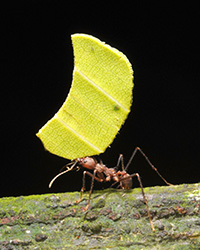Leaf cutter ant foraging (Version 1.0)
By Jeremy M Wojdak, Justin Touchon, and Myra Hughey

Module Description:
This module introduces students to leaf-cutter ants in the rainforests of Panama. Students derive their own research hypotheses regarding ant foraging or allometric scaling relationships.
This module was created as a way to give students a realistic, open-inquiry research experience, even when lab or field research is not possible. Students are introduced to leaf-cutter ants and how they forage, provided with images and videos, and are asked to develop a hypothesis, plan a study, collect real primary data, and analyze the data. Minimally the experience can take a couple of hours of class time and some report writing as homework. On the other end, full research papers or posters could be the product of a more rigorous research experience.
Potential Learning Objectives:
Basic
-
Students will be able to generate meaningful scientific hypotheses given a context for study.
-
Students will use image analysis software to generate data from an image set.
-
Students will be able to conduct and interpret linear regression analyses (including R2, p-values, hypothesis testing, slopes/y-intercepts), given data they've collected.
-
Students will write a results section in typical scientific literature format.
Advanced/Extensions
-
Students will be able to construct and interpret frequency histograms.
-
Students will apply programming concepts to automate a series of procedures.
-
Students will be able to conduct appropriate statistical analysis for a categorical independent and numerical dependent variable.
Teaching Setting:
This module can be used in a variety of teaching settings, including introductory or advanced undergraduate biology courses, high school, and AP biology. This module is designed to fit into a study of ecology, evolution, animal behavior, or the like. Alternatively, it could be used in a biostatistics course as an interesting context for analysis. Previous experience with image analysis is not required for either the instructor or the students.
QUBES Citation:
Wojdak, J. M., Touchon, J., Hughey, M. (2018). Leaf cutter ant foraging. AIMS: Analyzing Images to learn Mathematics and Statistics, QUBES Educational Resources. doi:10.25334/Q4RB0M
|